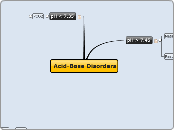Acid-Base Disorders
pH < 7.35
PCO2
< 35
HCO3
< 24
Metabolic Acidosis (Single)
Anion Gap
10-12
Hyperchloremic
Urine anion gap
< -20
Diarrhea
Ext. loss of secretions in GI
Pancreatic
Biliary
> -20
Hypokalemic
NH4CL Admin.
Urine pH < 5
Proximal RTA
No change in Urine pH
Classical distal RTA
Hyperkalemic
Type 4 RTA
RTA of renal insufficiency
> (10-12)
High AG
Delta Ratio
Osmolar Gap
10-15
MUDPILES
Malnutrition
Uremia
Rx: Dialyze
GFR < 15-20
DKA
Rx: Insulin
B-OH-butyric acid
Acetoacetic acid
Paraldehyde
INH
Young women, Suicide
Lactic acid
Rx: Pressors
Hypoxia
Salicylates
> (10-15)
Methanol
Rx: Dialysis
Produces formic acid
EtOH
Ethylene glycol
Produces glycolic, oxalic acids
Propylene glycol
<0.4
Hyperchloremic normal anion gap acidosis
<1
High AG & Normal AG acidosis
1-2
Pure High AG Acidosis
>3
High AG + concurrent met. alk or pre-existing comp. resp acid
> 28
Mixed
> 45
HCO3
< 24
Mixed
> 28
Compensatory Rate
1 Bicarb per 10 pCO2
Acute Respiratory Acidosis (Single Disorder)
4 Bicarb per 10 pCO2
Chronic Respiratory Acidosis (Single Disorder)
Causes
Central
Stroke
Infection
Anesthetics
Neuromuscular
Pulmonary
Airway
Parenchyma
Miscellaneous
Hypoventilation
Obesity
pH > 7.45
Metabolic
Cl- sensitive (volume depleters)
Loop, Thiazide Diuretics
Decreased ECV
Increased RAAS
Increased Aldo
Decreased H+, K+
Vomiting
Cl- resistant
Stimulates Aldo
RAAS, Adrenal tumors
Severe hypokalemia
Respiratory
CNS lesions
Distress
Hypoxemia
Anxiety
Pain
Pregnancy
Salicylates
Hepatic failure
